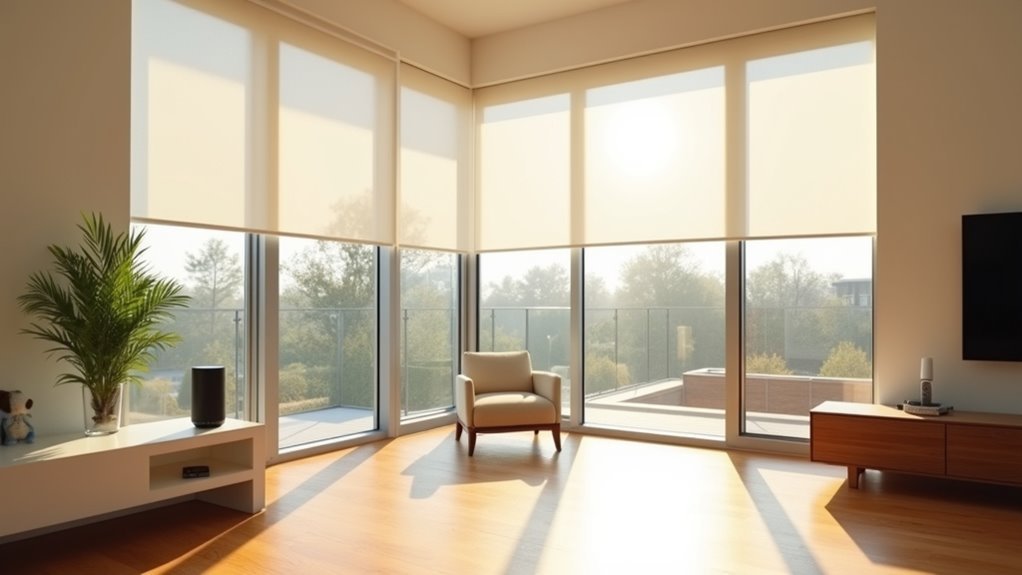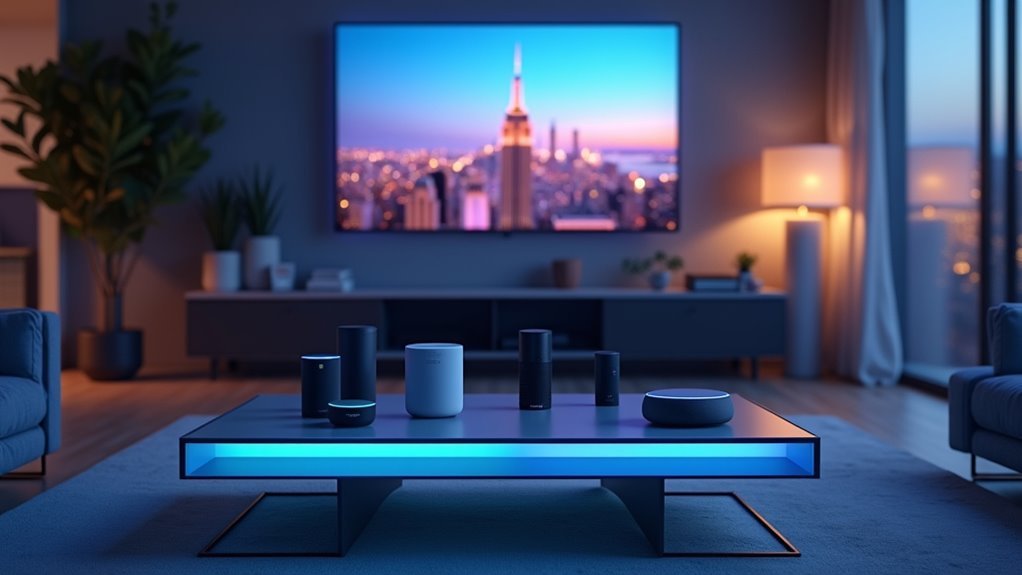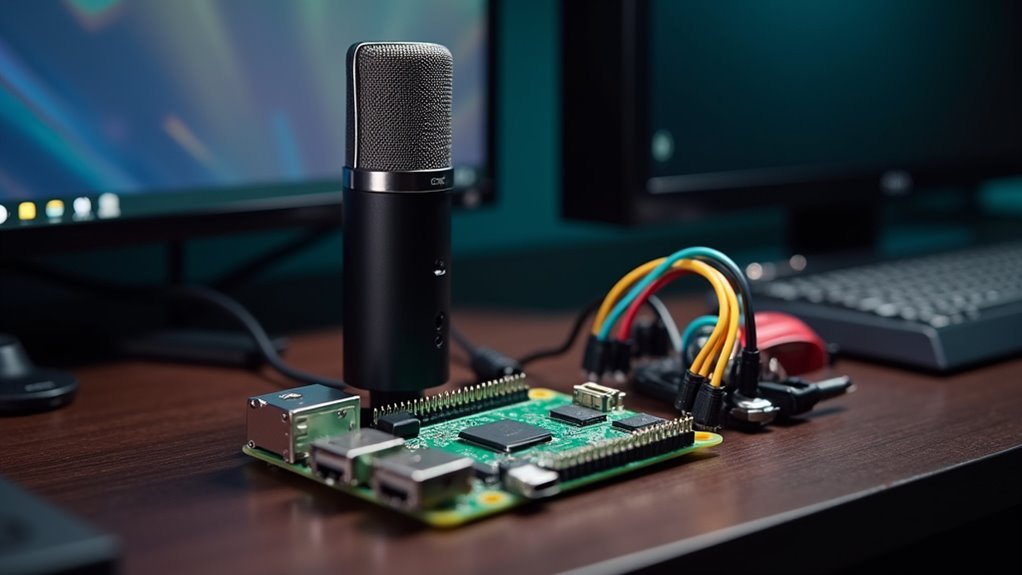You’ve probably heard about smart homes becoming more popular, but you might not realize how much control you’re missing when your window blinds aren’t connected to your automation system. Zigbee blinds represent an essential piece of the smart home puzzle that most homeowners overlook, yet they can dramatically transform how you manage privacy, lighting, and energy efficiency throughout your day. There’s more to this technology than simple remote control.
Understanding Zigbee Protocol for Smart Window Treatments

Smart window treatments have evolved dramatically with the introduction of Zigbee protocol, a wireless communication standard that’s transforming how you’ll control and automate your blinds.
This interoperable and secure IoT communication protocol enables seamless connectivity between your smart home devices within a unified network.
When you choose Zigbee 3.0 certified blinds, you’re ensuring compatibility with major platforms like TaHoma, SmartThings, and Echo devices.
The protocol’s bi-directional communication lets you monitor real-time data including blind positions and battery status through compatible apps.
What sets Zigbee apart for home automation is its local operation capability—your smart blinds remain functional even during internet outages.
You can expand your system efficiently with up to 50 end devices per network while maintaining robust device communication.
Key Features of Zigbee-Enabled Blind Motors
When you’re evaluating Zigbee-enabled blind motors, you’ll discover they’re engineered with advanced features that transform your window treatment experience. These Zigbee smart motors deliver bi-directional communication, letting you monitor blind positions and battery status through apps like TaHoma. You’ll enjoy seamless integration with Google Home, Amazon Alexa, and Apple HomeKit for thorough home automation.
| Feature | Benefit |
|---|---|
| USB-C/Magnetic Charging | Convenient power solution |
| 50-Device Network Capacity | Scalable automation setup |
| Quiet Operation | Peaceful environment |
| Bi-directional Communication | Real-time status monitoring |
The motors support up to 50 devices within a single Zigbee network, ensuring scalability for your automation needs. You’ll appreciate their whisper-quiet operation that maintains tranquility while providing customizable light control and privacy management throughout your home.
Benefits of Automated Window Coverings in Smart Homes

You’ll discover that automated window coverings deliver significant energy savings by optimizing natural light and reducing your heating and cooling costs throughout the year.
These smart blinds give you precise control over privacy levels, allowing you to adjust coverage instantly from anywhere using your smartphone or voice commands.
You can also schedule your blinds to open and close automatically, creating the appearance of occupancy even when you’re away from home.
Energy Efficiency Gains
Since automated window coverings optimize natural light usage throughout the day, you’ll dramatically reduce your reliance on artificial lighting and slash your electricity bills.
Your Zigbee device delivers substantial energy efficiency gains through intelligent automation that adapts to changing conditions.
Here’s how smart blinds maximize your energy savings:
- Schedule-based operation – Automatically open and close based on time and weather conditions to reduce heating and cooling costs by up to 20%
- 100% light blocking capability – Motorized blackout shades prevent winter heat loss and summer heat gain
- Silent thermal comfort control – Enhance indoor temperature regulation without noise disruption
- Real-time ecosystem integration – Communicate with thermostats and sensors to create adaptive, energy-efficient automation that responds instantly to environmental changes
Enhanced Privacy Control
Beyond energy savings, Zigbee blinds transform your home’s privacy management through intelligent automation that adapts to your daily routine.
You can schedule these smart blinds to automatically close at specific times, preventing outsiders from peering into your home when darkness falls outside.
Remote control capabilities through smart home integration mean you’ll maintain privacy even when you’re away.
Your automated window coverings respond to environmental cues like sunlight intensity and time of day, ensuring privacy without blocking beneficial natural light.
Zigbee’s bi-directional communication lets you monitor blind status through the TaHoma app, confirming your privacy settings are active.
These smart blinds also enhance safety by eliminating manual cords that pose risks to children and pets while preserving complete privacy control.
Installation Process for DIY Zigbee Blind Systems
Installing Zigbee blinds represents one of the most straightforward smart home upgrades you can tackle in a single afternoon.
The installation typically takes about 10 minutes per window and can be completed using DIY-friendly guides included with your Smart Shading product.
Here’s your installation roadmap:
- Mount the blinds following the manufacturer’s step-by-step instructions
- Insert 4 AA batteries into the motor unit for approximately 6 months of operation
- Connect to your Zigbee hub such as Echo devices or SmartThings using the device-specific manual
- Test signal range and install repeaters like Somfy smart plugs if needed for dependable operation
You’ll need to verify your smart home system supports the Zigbee protocol before beginning installation for peak functionality.
Compatible Smart Home Platforms and Integration Options

Once you’ve completed the physical installation, your Zigbee blinds can integrate with virtually every major smart home platform on the market today.
You’ll find seamless compatibility with Amazon Alexa, Google Home, and Apple HomeKit, enabling voice control and automation throughout your smart home ecosystem.
Zigbee 3.0 certified devices communicate directly through compatible hubs like SmartThings, Eero 6, and Home Assistant, simplifying your connection process.
The TaHoma switch by Somfy provides a unified platform supporting both Zigbee and RTS technologies, letting you manage multiple device types effortlessly.
You can leverage advanced scheduling options to automate blinds based on sunrise, sunset, or custom routines.
Bi-directional communication allows you to monitor blind positions and battery statuses through dedicated applications.
Battery Life and Power Management for Wireless Blinds
You’ll typically get about 6 months of battery life from your Zigbee blinds’ 4 AA batteries with daily opening and closing.
You can monitor remaining power through the TaHoma app, which sends low battery alerts before they die completely.
Modern models offer convenient USB-C charging or magnetic dongles, eliminating the hassle of removing and replacing traditional batteries.
Battery Life Expectations
Battery performance stands as one of the most critical considerations when choosing Zigbee smart blinds for your home automation system.
You’ll typically get approximately six months of operation from four AA batteries with daily use. The TaHoma app provides real-time battery level monitoring, ensuring you’re never caught off guard by power depletion.
Here’s what you can expect from your Zigbee blind battery performance:
- Standard Operation: Opening and closing once daily yields roughly 180 days of battery life
- Remote Monitoring: Check battery level status through your smartphone app
- Low Battery Alerts: Receive notifications before complete power loss occurs
- Charging Options: Many models support USB-C or magnetic dongle charging for convenience
This reliable power management eliminates frequent maintenance while maintaining consistent automation performance.
Charging Options Available
Modern Zigbee blinds offer multiple charging solutions that eliminate the traditional hassle of battery replacement.
You’ll find charging options available that include USB-C ports and magnetic dongles, allowing you to conveniently recharge your blinds without removing batteries. These innovative charging methods mean you won’t need to constantly purchase new AA batteries every six months.
When your blinds do require battery changes, manufacturers have designed them to be easy to replace. You can simply swap out the four AA batteries through accessible compartments.
The bi-directional communication feature lets you monitor battery levels through compatible apps like TaHoma, so you’ll know exactly when charging or replacement is needed, ensuring your blinds never unexpectedly stop working.
Remote Control and Voice Assistant Capabilities
While traditional window coverings require manual adjustment, Zigbee blinds offer seamless remote control through compatible smart home hubs and smartphone apps.
You’ll enjoy operating your blinds from anywhere using your smartphone or the included IR remote control. Voice commands make operation even more convenient through integration with popular assistants.
Your Zigbee blinds provide these advanced control capabilities:
- Voice Assistant Integration – Control blinds hands-free with Amazon Alexa, Google Home, and Apple HomeKit voice commands
- Smart Scheduling – Set automated routines, timers, and schedules through smart home platforms for enhanced energy efficiency
- Scene Creation – Use the TaHoma® by Somfy app to create custom scenes that adjust multiple blinds simultaneously
- Status Monitoring – Check blind position and battery levels directly through your smartphone app via bi-directional communication
Scheduling and Automation Settings for Daily Routines
Beyond simple remote operation, Zigbee blinds transform your daily routine through intelligent scheduling and automation features that adapt to your lifestyle. You can program them to open at sunrise and close at sunset automatically, enhancing both convenience and energy efficiency throughout your day.
The TaHoma® by Somfy app streamlines setup by offering custom scenes alongside suggested presets, letting you adjust blinds for specific times or activities.
Advanced scheduling options integrate seamlessly with your smart home platform routines, creating automated adjustments based on your personal habits and preferences.
Even when internet connectivity fails, your blinds continue operating according to pre-set schedules through offline control via included remotes.
Your smart blinds maintain reliable operation even during internet outages, continuing automated schedules through dependable offline remote control functionality.
The bi-directional communication feature monitors blind position and battery status through the TaHoma app, ensuring peak performance.
Popular Zigbee Blind Brands and Product Comparisons
When you’re shopping for Zigbee blinds, you’ll find several standout manufacturers offering different features and price points to match your specific needs.
THIRDREALITY, Am43, Yoolax, and IKEA’s Fyrtur line each bring unique advantages, from ultra-affordable options starting at $23.99 to premium light-blocking designs.
You’ll want to compare their smart integration capabilities, installation requirements, and customization options to find the perfect fit for your home automation setup.
Top Zigbee Manufacturers
Several leading manufacturers have established themselves as go-to brands for Zigbee-enabled smart blinds, each offering distinct advantages for different budgets and installation preferences.
When you’re shopping for Zigbee blinds, these top manufacturers deliver reliable solutions:
- Somfy – Premium smart shading systems with seamless integration and extensive smart home compatibility.
- THIRDREALITY – Budget-friendly motorized blackout blinds featuring simple DIY installation and broad hub compatibility.
- Am43 – Customizable motorized roller blinds with MQTT setup starting at $23.99, perfect for energy-efficient automation.
- Yoolax and IKEA Fyrtur – Stylish window treatments that integrate smoothly with existing smart home ecosystems.
You’ll also find Zemismart offering hardwired WiFi motors with Matter support for advanced automation needs.
Each brand targets different user requirements, from basic automation to sophisticated smart home integration.
Feature Price Comparisons
Three major price tiers define the Zigbee blind market, with entry-level options like Am43 starting at $23.99, mid-range solutions from THIRDREALITY reaching $50-70, and premium brands like Somfy commanding $100+ for advanced features.
When making price comparisons between Zigbee blinds, you’ll find significant value differences based on included features. Am43’s budget-friendly roller blinds offer basic automation with MQTT customization, while THIRDREALITY’s honeycomb models provide superior blackout capabilities and six-month battery life for moderate pricing.
Premium options deliver whisper-quiet motors and advanced integration capabilities.
You should consider total ownership costs beyond initial purchase prices. Battery replacement frequency, motor durability, and compatibility with your existing smart home ecosystem affect long-term value.
IKEA’s Fyrtur series offers middle-ground pricing with reliable performance, while Yoolax provides customizable motor solutions for specific installation requirements.
Smart Integration Options
Although price remains an essential factor, smart integration capabilities ultimately determine how well your Zigbee blinds will function within your existing home automation ecosystem.
You’ll find these smart home integration options across leading brands:
- Voice Control Compatibility – Yoolax and IKEA Fyrtur shades seamlessly connect with Amazon Alexa and Google Home, enabling hands-free operation through simple voice commands.
- Hub Integration – Most Zigbee blinds require a compatible smart home hub for full functionality, allowing centralized control through your existing automation system.
- MQTT Customization – Am43 motorized roller blinds offer advanced MQTT settings, providing tech-savvy users with deeper customization options for complex automation scenarios.
- Emerging Standards Support – Zemismart’s Matter-compatible motors showcase forward-thinking connectivity, ensuring compatibility with future smart home platforms and reducing obsolescence concerns.
Troubleshooting Common Connectivity Issues
When your Zigbee blinds start experiencing connectivity problems, the most common culprit is insufficient signal range between your devices and the TaHoma smart hub.
You’ll need to guarantee your Zigbee devices stay within proper range, or install a repeater like the Somfy smart plug to extend coverage.
Check that your devices are Zigbee 3.0 certified for proper TaHoma switch compatibility.
If blinds keep going offline, verify battery levels since low power affects performance considerably.
Review your installation to confirm all connections are configured correctly and that you’ve completed necessary hub and device updates.
When pairing fails, consult each device’s specific manual, as different models have unique integration requirements for successful Zigbee network connection.
Cost Analysis of Zigbee Vs Other Smart Blind Technologies
Since budget considerations often determine which smart blind technology homeowners choose, Zigbee models consistently deliver the most cost-effective entry point into automated window treatments.
Your cost analysis reveals substantial savings compared to alternatives like Z-wave or WiFi options that require expensive hubs or ongoing subscriptions.
Zigbee eliminates the costly hub requirements and subscription fees that make Z-wave and WiFi alternatives significantly more expensive long-term.
Here’s how Zigbee blinds maximize your investment:
- Initial Purchase – Starting at $23.99, they’re considerably cheaper than premium brands like Lutron.
- Installation Savings – DIY-friendly design eliminates professional installation fees.
- System Integration – One protocol handles multiple devices, reducing equipment costs.
- Energy Efficiency – Automated light control and scheduling features lower monthly utility bills.
You’ll consolidate smart home functionalities without purchasing diverse protocols, while the interoperability guarantees long-term compatibility with future devices.
Security and Privacy Considerations for Connected Blinds
While convenience drives smart blind adoption, security concerns shouldn’t take a backseat to automation benefits. Zigbee blinds offer robust security through encrypted communication protocols that protect your data transmission between devices.
Unlike cloud-dependent systems, Zigbee operates locally without internet connectivity, reducing exposure to external breaches and enhancing your privacy.
The protocol’s bi-directional communication lets you monitor blind status and battery life through the TaHoma app while maintaining secure operations. You’ll appreciate that voice-controlled adjustments and automated scheduling stay within the protected Zigbee network.
However, you must prioritize regular firmware updates and compatibility checks. Vulnerabilities can develop over time, so proactive management remains essential for safeguarding your connected environment’s security and maintaining ideal privacy protection.
Expanding Your Zigbee Network With Additional Devices
Once you’ve established your Zigbee blinds as the foundation of your smart home, you can build an interconnected ecosystem by adding compatible devices that work seamlessly together.
Your Zigbee network supports up to 50 end devices, giving you plenty of room to expand.
Here’s how to enhance your system:
- Add Smart Sensors – Motion detectors, temperature sensors, and door/window sensors that integrate with your blinds for automated responses.
- Install Additional Lighting – Zigbee 3.0 compatible smart bulbs and switches that coordinate with your blinds for complete ambiance control.
- Deploy Signal Repeaters – Smart plugs like Somfy’s model extend your network range and strengthen connectivity.
- Integrate Third-Party Devices – Zigbee’s interoperability lets you mix manufacturers while maintaining centralized control through platforms like TaHoma.
Maintenance and Long-term Performance of Automated Blinds
Your expanding Zigbee network requires ongoing care to maintain peak performance across all devices.
Zigbee blinds typically run on battery power for approximately six months under normal usage, minimizing maintenance requirements. You’ll want to regularly monitor battery status through the TaHoma app, which provides performance tracking and low battery alerts for enhanced usability.
The bi-directional communication feature lets you view blind position and battery levels, promoting proactive maintenance and timely replacements.
Keep blind mechanisms clean by removing dust and debris, as this enhances motorized system lifespan and functionality.
Most Zigbee blinds feature DIY-friendly installation and maintenance designs. Manufacturers provide troubleshooting support, ensuring you can efficiently manage upkeep tasks yourself without professional assistance.
Frequently Asked Questions
How Does Zigbee Work in Home Automation?
Zigbee creates a mesh network where your smart devices communicate wirelessly with each other. You’ll need a compatible hub to manage connections, and your devices work locally without internet, ensuring reliable home automation.
What Is the Point of Smart Blinds?
You’ll automate light control and improve energy efficiency while enhancing convenience. Smart blinds adjust automatically to environmental conditions, integrate seamlessly with your smart home system, and let you create custom schedules matching your daily routines.
What Is Somfy Zigbee?
Somfy Zigbee’s a smart home technology that lets you control motorized blinds and shades wirelessly. You’ll get automatic sunrise/sunset operation, battery monitoring, and compatibility with major smart home platforms like Alexa and Google Home.
What Are Automated Blinds?
You’ll find automated blinds are motorized window coverings you can control remotely or program to operate on schedules. They’ll enhance your home’s convenience, energy efficiency, privacy, and ambiance while integrating seamlessly with smart home systems.





Leave a Reply